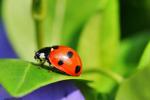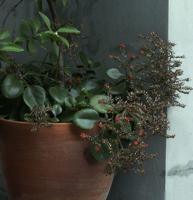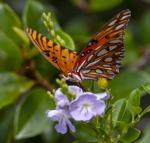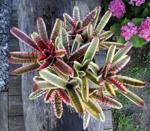Garden columnist Dan Gill answers readers' questions each week. To send a question, email Gill at gnogardening@agcenter.lsu.edu.
I was at the farmers market, and we were talking about the difference between fruits and vegetables. I was told that vegetables do not have seeds and fruits do. I am somewhat confused because I think there are vegetables that have seeds – like tomatoes, squash and peppers. I went to the internet, and I am now even more confused. Is there a good explanation about the difference between fruits and vegetable? Jessie Blake
This is an interesting question. The definition you were given that vegetables do not have seeds and fruits do is just wrong. Plenty of vegetables have seeds. And some vegetables, like green peas and red beans, are seeds. The common usage of these two words, fruit and vegetable, has a lot to do with how we eat them.
Some of the confusion arises from the differing ways the word fruit is used in common usage and how it is used botanically.
Botanically, the term “fruit” refers to the structure of a flowering plant (generally, the mature ovary) that encloses the seeds. So, botanically, acorns, okra pods, apples, tomatoes, peaches, sunflower seeds, peppers and green beans are all botanical examples of fruit.
In common usage, the term fruit refers specifically to the sweet, fleshy, juicy fruit produced by a wide variety of flowering plants. Fruits are generally sweet and are most often consumed as an accessory to the main course — such as desert or appetizer.
Some of the vegetables we eat are, botanically, the fruit of the plants that produce them. The only reason that this sounds odd is that the common usage of the word “fruit” is different from the botanical meaning of the word.
In common usage, the word “vegetable” is used to refer to a plant part, generally not sweet, that forms an important part of the main course of the meal.
What we call vegetables come from virtually every part of plants, including roots, stems, leaves, flowers, fruit and seeds. Examples: roots — carrot, turnip; tubers — Irish potato; tuberous roots — sweet potato; bulbs — onion, garlic; stems — kohlrabi; leaves — lettuce, spinach; flower buds — broccoli, artichoke; fruits — tomato, pepper, squash, cucumber, melon, green beans and eggplant; seeds — green peas, red beans, black-eyed peas.
To some people, it seems odd to say a vegetable like a tomato is the fruit of the tomato plant. But that is no different from saying a carrot is actually a root, or turnip greens are actually leaves, or red beans are actually seeds. You are simply naming the botanical part of the plant we are eating as a vegetable.
It is meaningless to ask if a tomato is a fruit or a vegetable. That’s like asking is a carrot a root or a vegetable. A tomato is the fruit of the tomato plant, and we eat it as a vegetable. A carrot is the root of a carrot plant, and we eat it as a vegetable.
Of course, there are lots of exceptions. But it is better to simply acknowledge them than dwell on them. Sweet potatoes, for instance, serve as both fruit (sweet potato pie served as dessert) and vegetable (sweet potato casserole served with the main course).
One final distinction between fruit and vegetable. Most of what we call fruit comes from woody trees, shrubs and vines (strawberries, bananas and blackberries are exceptions). Most of what we call vegetables comes from herbaceous plants that do not produce woody stems.

Ladybugs help control aphids in the garden.
I would like to introduce more ladybugs as well as praying mantises to my garden. How should I do this without the mantises eating the ladybugs? Bonnie Lofton
As far as I know, praying mantises will eat any insect they encounter. Ladybugs should be released onto plants already infested with aphids. They must have something to eat or else they will just fly away and look for food elsewhere. So, release the ladybugs where you need them for aphid control. Release the praying mantises somewhere else in your yard as far away from the ladybugs as possible.
Garden tips
WATCH FOR WHITE POWDER: Powdery mildew on many ornamentals (crape myrtles, roses) and vegetables (squash, cucumbers) can be a problem this time of year. Treat with neem oil, chlorothalonil or other labeled fungicides.
GLAD TIDINGS: When gladioli finish blooming (corms should have been planted back in March), prune off the faded flower spike but leave the foliage intact. The foliage will produce food that is stored in the newly developing corm insuring a large, healthy corm that will bloom well next year.
BLIGHT PREVALENT: Vegetables like peppers and tomatoes are experiencing various fungal leaf spots and fruit rots such as early blight, late blight, Septoria leaf spot, buckeye rot and anthracnose, as well as bacterial spot. If you are having problems in your landscape or gardens, be sure to get the proper diagnosis and determine what, if anything, should be done. For help, contact your local LSU AgCenter extension horticulturists.
MOW OFTEN: Mow lawns as often as you can between rains. Allowing lawns to get badly overgrown before mowing is detrimental to the health of the lawn grass. Avoid mowing the lawn when the grass blades are wet. This increases problems with clippings clumping and matting on the surface of the lawn. Or, use a bag attachment.
LOW WATER: Try to avoid wetting the foliage of plants prone to leaf diseases, like vegetables, bedding plants and roses. Wetting the foliage encourages fungal diseases to attack. Direct water at the base of plants or use soaker hoses to irrigate.
"vegetable" - Google News
May 17, 2022 at 07:00PM
https://ift.tt/4JUZIcR
Fruit or vegetable? Dan Gill says the real difference is in how they're eaten - NOLA.com
"vegetable" - Google News
https://ift.tt/nSlA6yt
https://ift.tt/qITU2uv
Bagikan Berita Ini

















0 Response to "Fruit or vegetable? Dan Gill says the real difference is in how they're eaten - NOLA.com"
Post a Comment